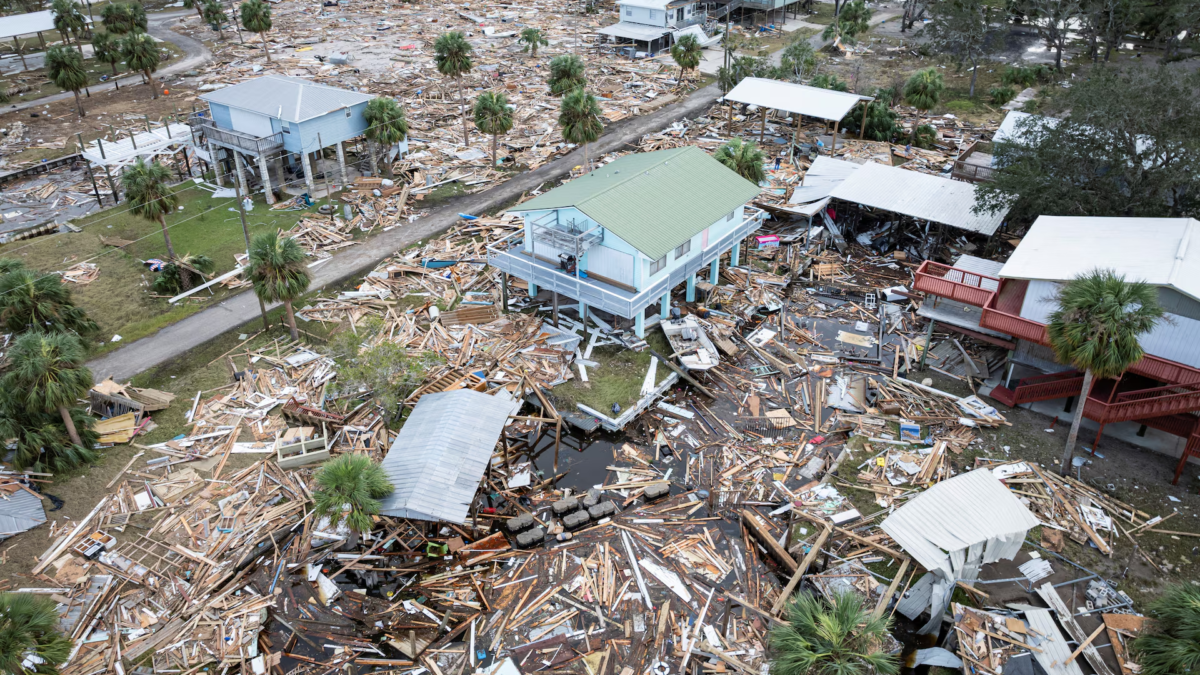Climate change continued across the UK in 2020 – 2020 was the first year that rainfall, temperature, and sunshine values all were in the top ten in the same year
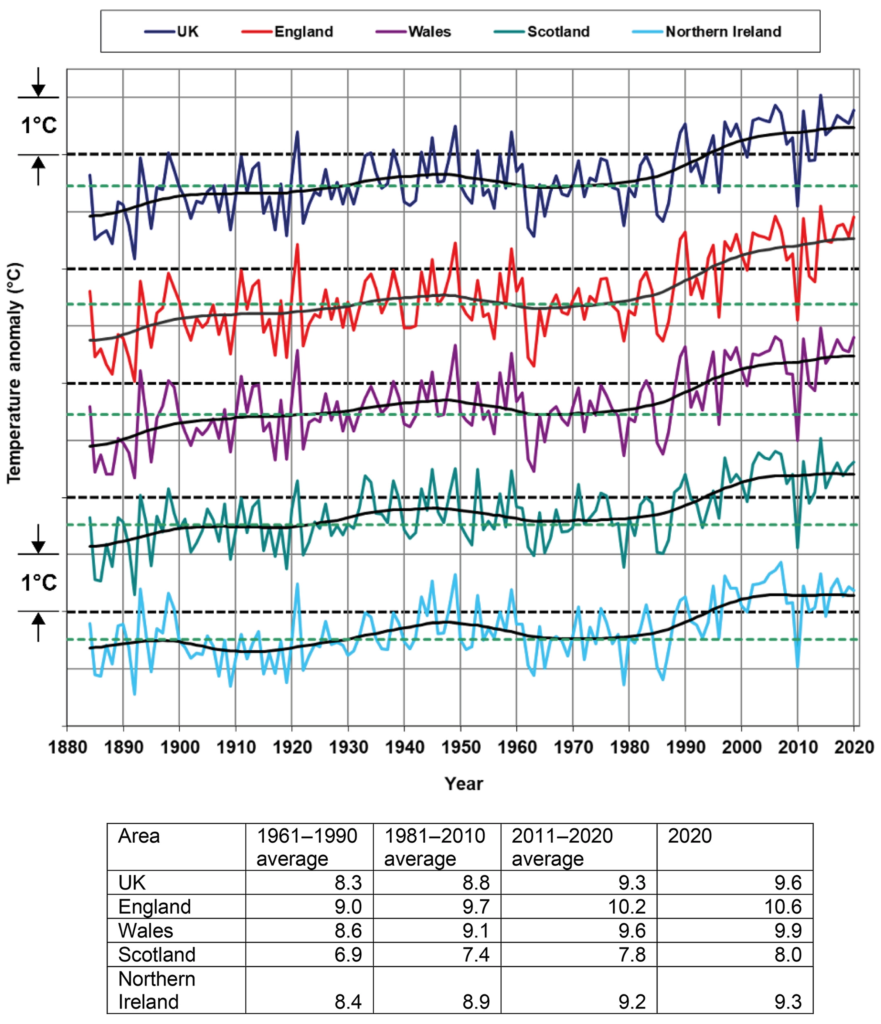
By Karen Graham
29 July 2021
(Digital Journal) – The United Kingdom’s climate has continued to warm, with the decade 2011–2020 providing a 10-year “snapshot” of the most recent of the UK’s climate events and how this compares to historical records.
According to the Met Office, The Royal Meteorological Society’s latest analysis of the UK climate – State of the UK Climate 2020 – published in the International Journal of Climatology on 28 July 2021, shows that climate change is already being felt across the UK.
The report makes use of observational records on temperature, precipitation, sunshine, and wind speed from the UK land weather station network as managed by the Met Office and a number of key partners, and conform with the standards of the World Meteorological Organization (WMO).
2020 was another notable year for the UK climate, with records broken for daily rainfall and monthly sunshine hours. Average temperatures for the UK continue to climb, with nearly a degree of warming when comparing the most recent 30 years with the preceding 30-year period. Last year saw some significant weather extremes including severe flooding from heavy rainfall in February and a major heatwave in early August.
Mike Kendon, Senior Climate Scientist at the Met Office
This most recent report is the seventh in a series of State of the Climate UK publications that provides an accessible, authoritative, and up-to-date assessment of UK climate trends, variations, and extremes.
With climate records and data dating back to 1884, the top ten warmest years in the UK have occurred since 2002, and looking at central England, the 21st century has turned out to be the warmest in three hundred years.
More significantly, 2020 was the first year that the annual values for rainfall, temperature and sunshine were all in the top ten in the same year. 2020 was third warmest, fifth wettest and eighth sunniest on record for the UK. [more]
Met Office – Climate change continues to be evident across the UK
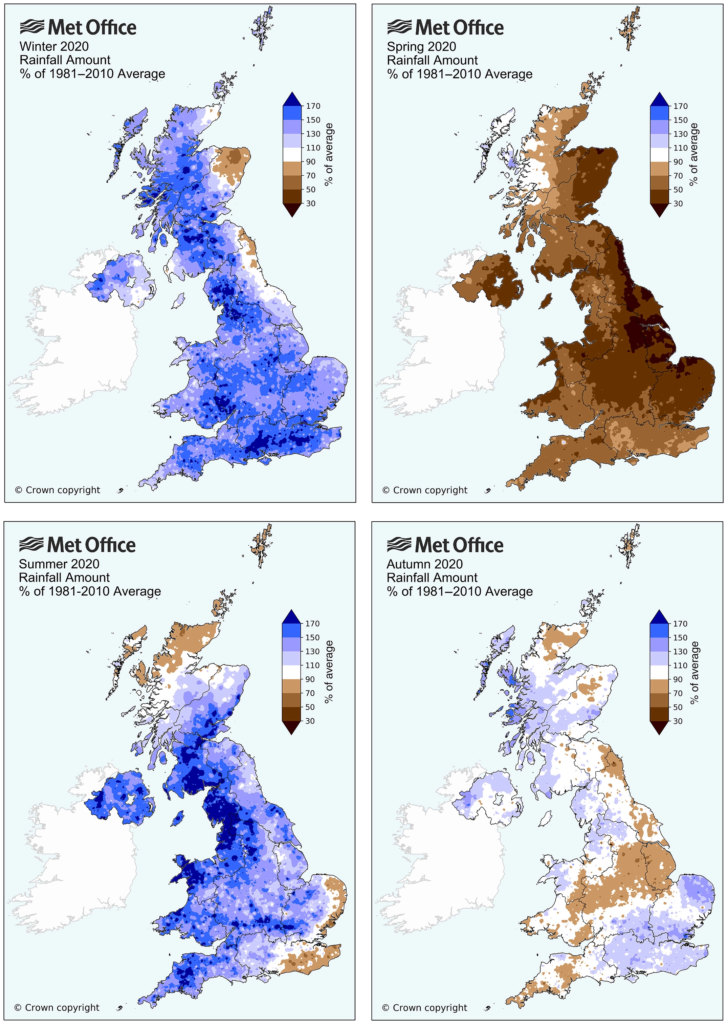
The State of the UK Climate 2020
28 July 2021 (Royal Meteorological Society) – In February 2020, hundreds of properties were affected by devastating flooding from storms Ciara and Dennis arriving only one week apart in what was the wettest February on record for the UK. In August 2020, a major heatwave affected much of southern England. And in October 2020, the UK recorded its wettest day on record.
Climate change has already increased the risks and impacts of these types of extreme weather events in the UK. Around the world, the intensity and frequency of heatwaves, such as the recent event in Canada, may be attributed to climate change, and, since a warmer atmosphere can hold more moisture, this link may also extend to extreme rainfall.
In this country, we are lucky to have a rich legacy of observational data from systematic networks of weather stations. That legacy stretches back to the origins of the Met Office in the 19th century, and early instrumental measurements in the 17th century. This observational record – with routine monitoring an important legacy of our Victorian predecessors – is vital in providing us with a long-term context. So, what do these observations tell us about the current state of our climate?
What is the State of the UK Climate report?
The State of the UK Climate 2020 report provides an accessible, authoritative and up-to-date assessment of UK climate trends, variations and extremes based on the most up-to-date observational datasets of climate quality. The report is an annual publication by the Met Office, published as a Special Supplement to the Royal Meteorological Society’s International Journal of Climatology.
The report presents a summary of the UK weather and climate through the year 2020, looking at key variables – temperature and rainfall – as well as sunshine, wind and snow. It compares year 2020 against the most recent decade 2011-2020 (our most recent experience of the UK’s climate), 30-year averages for 1981-2010 and 1961-1990, while the full climate series provide a critical long-term perspective. This year’s report also contains a first look at the 1991-2020 climatological reference period.
Much of the report is based on the HadUK-Grid dataset of 1km resolution gridded climate data for the UK, built from the full collection of historical weather station observations stretching back to 1862. It is a key resource for monitoring the UK’s climate. The report also includes a section on sea level rise around the UK by the National Oceanography Centre and a summary of first leaf and bare tree dates for four common tree or shrub species by the Woodland Trust using Nature’s Calendar Citizen Science data.
What are the key findings?
The observations provide evidence that the UK’s climate is already changing. Recent decades have been warmer, wetter and sunnier than the 20th century.
All top-ten warmest years for the UK in a series from 1884 have occurred since 2002, and six of the ten wettest years for the UK in a series from 1862 have occurred since 1998.
The latest year is consistent with this general picture: 2020 was the third-warmest, fifth-wettest and eight sunniest year on record for the UK, and no other year has fallen in the top-ten for all three variables.
A preliminary comparison of 30-year long-term averages for the periods 1961-1990 and 1991-2020 show that the UK’s climate has warmed by 0.9°C with rainfall increasing by 6%.
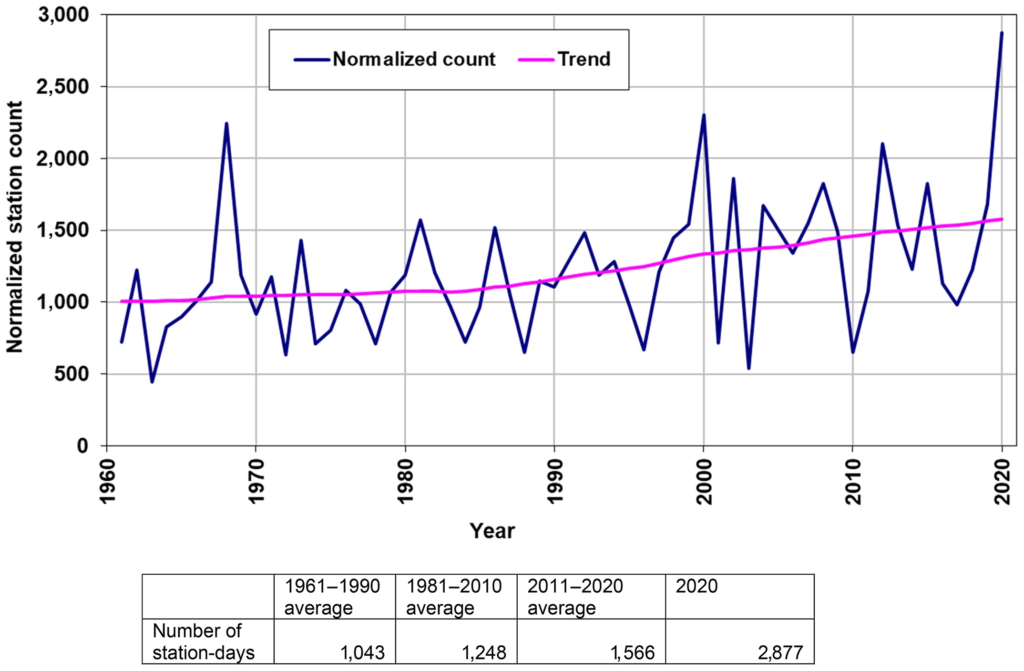
What about extreme weather events?
The inherently variable nature of the UK’s climate means that extreme weather events are to be expected in any given year. However, the extreme weather events of 2020 are generally consistent with this picture of a changing climate, particularly an increase in high temperature and high rainfall extremes.
37.8°C was recorded on 31st July, the UK’s third warmest day on record, and southern England was affected by a significant heatwave in August, with 34°C exceeded for seven consecutive days. 34°C has been reached in seven of the last 10 years 2011-2020 compared to seven out of the previous 50 years 1961-2010. The likelihood of extreme summer temperatures affecting the UK has increased, for example a recent study on the hot UK summer 2018 found it was 30-times more likely as a result of human influence on the climate system.
Two of the three wettest days on record for the UK (in a series of more than 47,000 days) occurred in 2020; again with a recent study estimating that the record rainfall of 3 October 2020 was 2.5 times more likely as a result of this human influence.
Storms Ciara and Dennis formed part of the wettest February on record for the UK in a series from 1862, and for England and Wales since 1766 – these storms followed recent severe flooding only three months earlier in November 2019. The UK has recorded its wettest February, April, June, November and December on record – five out of twelve months – in just over ten years.
Overall this report paints a picture of the emerging influence of climate change in the UK’s observations. It is happening now, and this report helps illustrate and update the vital observational evidence.
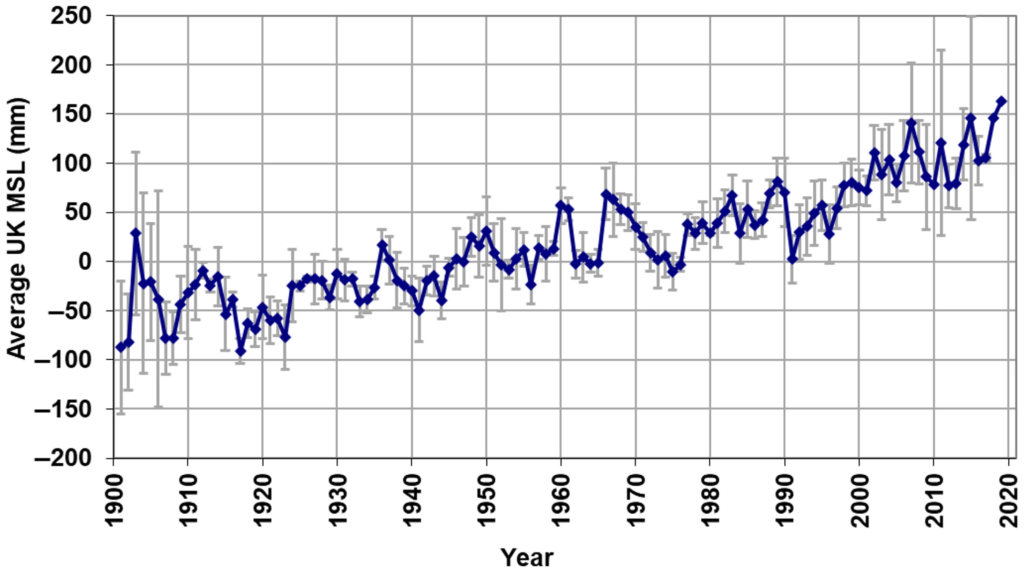
EXECUTIVE SUMMARY
- The UK’s climate is changing. Recent decades have been warmer, wetter and sunnier than the 20th century.
- Year 2020 was third warmest, fifth wettest and eight sunniest on record for the UK. No other year has fallen in the top-10 for all three variables for the UK.
- The UK has warmed at a broadly consistent but slightly higher rate than the observed change in global mean temperature.
Land temperature
- 2020 was the third warmest year for the UK in a series from 1884, and also third warmest for Central England in a series from 1659.
- 2020 included the fifth warmest winter (December 2019–February 2020), eighth warmest spring, sixth warmest January, equal-fourth warmest April and equal-sixth warmest November for the UK in series from 1884.
- All the top 10 warmest years for the UK in the series from 1884 have occurred since 2002.
- The most recent decade (2011–2020) has been on average 0.5°C warmer than the 1981–2010 average and 1.1°C warmer than 1961–1990.
- The Central England Temperature series provides evidence that the 21st century so far has overall been warmer than the previous three centuries.
Air and ground frost
- 2020 was the seventh consecutive year where the number of air and ground frosts was below the 1981–2010 average. The number of air and ground frosts were both fourth lowest in the series from 1960/1961.
- The most recent decade (2011–2020) has had 16% fewer days of air frost and 14% fewer days of ground frost compared to the 1981–2010 average, and 25%/20% fewer compared to 1961–1990.
Energy demand and growing conditions indices
- Heating degree days in 2020 were fifth lowest, and cooling and growing degree days equal-ninth/eighth highest, respectively for the UK in series from 1960.
- The most recent decade (2011–2020) has had 6% fewer heating degree days per year on average compared to 1981–2010 and 12% fewer compared to 1961–1990.
- The most recent decade (2011–2020) has had 7% more growing degree days per year on average compared to 1981–2010 and 17% more compared to 1961–1990.
Near-coast sea-surface temperature
- 2020 was the eighth warmest year for UK near-coastal sea-surface temperature (SST) in a series from 1870.
- The most recent decade (2011–2020) has been on average 0.3°C warmer than the 1981–2010 average and 0.7°C warmer than 1961–1990.
- Nine of the 10 warmest years for near-coast SST for the UK have occurred since 2002.
Precipitation
- 2020 was the UK’s fifth wettest year in a series from 1862, with 116% of the 1981–2010 average and 122% of the 1961–1990 average rainfall.
- February 2020 was the UK’s wettest February and fourth wettest calendar month on record in a series from 1862. It was the wettest February for England and Wales in a series from 1766.
- 2020 also included the fifth wettest winter, the fifth driest spring and, for England, the driest May on record in a series from 1862.
- 3 October 2020 was one of the UK’s wettest days on record in a daily series from 1891, with storms Ciara and Dennis on 8th/15th February and storm Bella on 26th December also in the UK’s top 40 wettest days.
- Six of the 10 wettest years for the UK in a series from 1862 have occurred since 1998.
- Since 2009, the UK has had its wettest February, April, June, November, December on record in monthly series from 1862—that is, five of 12 months—as well as the wettest winter on record.
- The most recent decade (2011–2020) has been on average 4% wetter than 1981–2010 and 9% wetter than 1961–1990 for the UK overall.
- For the most recent decade (2011–2020) UK summers have been on average 15% wetter than 1981–2010 and 17% wetter than 1961–1990. UK winters have been 11%/19% wetter.
Snow
- Any snow during 2020 mainly affected upland and northern areas, and there were no major widespread snow events.
- 2020 was one of the least snowy years on record.
- Widespread and substantial snow events have occurred in 2018, 2013, 2010 and 2009, but their number and severity have generally declined since the 1960s.
Sunshine
- 2020 was the eighth sunniest year for the UK in a series from 1919, with 109% of the 1981–2010 average and 113% of 1961–1990 average sunshine hours.
- Spring 2020 was the UK’s sunniest spring on record, and also sunnier than most UK summers. It included the sunniest April, and sunniest May, in series from 1919.
- The most recent decade (2011–2020) has had for the UK on average 4% more hours of bright sunshine than the 1981–2010 average and 8% more than the 1961–1990 average.
- For the most recent decade (2011–2020) UK winters have been 5% sunnier than 1981–2010 and 13% sunnier than 1961–1990. UK springs have been 11%/16% sunnier.
Wind
- Ten named storms affected the UK in 2020.
- This was a fairly typical year for storminess compared to recent decades.
- There are no compelling trends in storminess as determined by maximum gust speeds from the UK wind network over the last five decades.
Sea-level rise
- Mean sea level around the UK has risen by approximately 1.5 mm·year−1 on average from the start of the 20th century, excluding the effect of vertical land movement, resulting in an overall rise of 16.5 cm over that period.
- For the 20th century the rate of sea level rise around the UK is close to the estimate of the global sea level rise.
- The rate of sea level rise has increased recently, exceeding 3 mm·year−1 for the period 1993–2019.
Significant weather
- Severe and widespread flooding in February 2020, at least as severe as that of November 2019, was due to storms Ciara and Dennis, arriving only 1 week apart.
- On 31st July, 37.8°C was recorded in Greater London making this the UK’s third warmest day on record.
- In early August, southern England experienced one of the most significant heatwaves of the last 60 years with a succession of days exceeding 34°C and ‘tropical’ nights exceeding 20°C.
- On 16 August 2020, a rain-gauge in Norfolk recorded a daily total of 239.9 mm; the UK’s highest daily total in August on record at an individual station.
- 3 October 2020 and 15 February 2020 were two of the three wettest days on record UK-wide in over 47,000 days from 1891. Remarkably, four of the 41 days in this series with a UK total exceeding 20 mm occurred in 2020
- In terms of wind gusts, Storms Ellen and Francis were two of the most notable August storms to affect the UK in the last 50 years.
Preliminary 1991–2020 long term averages
- For the UK the period 1991–2020 has been on average 0.3°C warmer than 1981–2010 and 0.9°C warmer than 1961–1990, with warming across all months and countries.
- For the UK the period 1991–2020 has been on average 6% wetter than 1961–1990 but only 1% wetter than 1981–2010. Rainfall has increased by 5% in both winter and summer compared to 1981–2010 and 12%/7% compared to 1961–1990.
Phenology
- First leaf dates in 2020 were particularly early (on average 10.4 days earlier than the 1999–2019 baseline) for a range of common shrub/tree species, associated with mild conditions through January and February and some notable warmth and sunshine in April.
- End of season bare tree dates in 2020 were also slightly earlier (on average 4.3 days earlier than the 1999–2019 baseline) for the same species.
- Overall, the 2020 leaf-on season was extended by 6.2 days on average compared with the 1999–2019 baseline.
